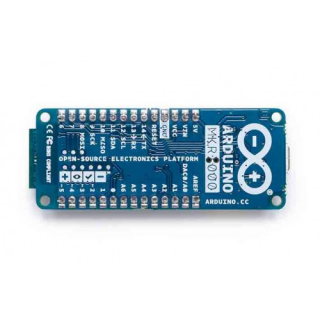On sale

- Send to a friend
-
- Remove this product from my favorite's list.
- Add this product to my list of favorites.
No specials at this time
No products added yet
On sale

Arduino MKR1000 has been designed to offer a practical and cost effective solution for makers seeking to add Wi-Fi connectivity to their projects with minimal previous experience in networking.It is based on the Atmel ATSAMW25 SoC (System on Chip), that is part of the SmartConnect family of Atmel Wireless devices, specifically designed for IoT projects and devices.
The ATSAMW25 is composed of three main blocks:
The ATSAMW25 includes also a single 1x1 stream PCB Antenna.
The design includes a Li-Po charging circuit that allows the Arduino/Genuino MKR1000 to run on battery power or external 5V, charging the Li-Po battery while running on external power. Switching from one source to the other is done automatically.A good 32 bit computational power similar to the Zero board, the usual rich set of I/O interfaces, low power Wi-Fi with a Cryptochip for secure communication, and the ease of use of the Arduino Software (IDE) for code development and programming. All these features make this board the preferred choice for the emerging IoT battery-powered projects in a compact form factor.The USB port can be used to supply power (5V) to the board.The Arduino MKR1000 is able to run with or without the Li-Po battery connected and has limited power consumption.
The MKR1000 Wifi module supports certificate SHA-256.
Warning: Unlike most Arduino & Genuino boards, the MKR1000 runs at 3.3V. The maximum voltage that the I/O pins can tolerate is 3.3V. Applying voltages higher than 3.3V to any I/O pin could damage the board. While output to 5V digital devices is possible, bidirectional communication with 5V devices needs proper level shifting
Q: I plugged the board to my PC / MAC but I cannot see the serial port listed on the IDE, I cannot upload sketch to the board!
A: The first thing to try is manually put the CPU into bootloader mode, this is accomplished by pressing quickly twice the reset button (you need a pencil to actually push the button).
Another try is to change the USB cable: some micro-USB cables are "power only", you'll see the board powered but no data connection to the PC.
Q: I plugged the board, I can see the serial port but I cannot upload sketch
A: If still on, remove the conductive foam that protects the pins.
Q:What if I have issues with TLS/SSL connections?
A: you can upload a custom SSL certificate by using the firmware updater. See the full guide
Q: What's the pin number of the onboard LED? Pin 13 seems to not work...
A: The LED is connected to pin 6, but you can use the LED_BUILTIN constant instead of declaring the pin number.
Q: What does the CHRG LED blinking indicate?
A: Indicates that the board is charging the LiPo battery connected to the white JST connector. Please note that the charger use a constant current of 350mA, this means that you must use a LiPo battery with a minimum capacity of 700mAh otherwise you risk unpleasant side-effects like flames and/or explosions.
Q: After some time the Charge LED starts blinking even if no battery is attached to the JST connector
A: The CHARGE LED on the board is driven by the charger chip. This LED starts to blink at a frequency of about 2Hz (slow blink) if a defective or no battery is connected to the JST connector.
Q: I see that A0 is marked as DAC0. There is a DAC on that pin? is usable?
A: Yes, there is a DAC and it's usable, you can control the pin with analogWrite(..).
Q: Which is the VIN range voltage value?
A: VIN Nominal voltage value is 5V, range is from 5V to 6V (6V is the Maximum)
Q: Which is the polarity of the battery?
A: Looking at the connector pins: Left = Positive, Right = GND
Q: What Vin, 5V and VCC means?
A: Vin.
This pin can be used to power the board with a regulated 5V source. If the power is fed through this pin, the USB power source is disconnected. This is the only way you can supply 5v (range is 5V to maximum 6V) to the board not using USB. This pin is an INPUT.
5V.
This pin outputs 5V from the board when powered from the USB connector or from the VIN pin of the board. It is unregulated and the voltage is taken directly from the inputs. When powered from the battery it supplies around 3.7 V. As an OUTPUT, it should not be used as an input pin to power the board.
VCC.
This pin outputs 3.3V through the onboard voltage regulator. This voltage is the same regardless the power source used (USB, Vin and Battery).